FILM MUSIC RECORDINGS REVIEWS |
|
|
FILM MUSIC RECORDINGS REVIEWS |
|
|
FEBRUARY 1999 Part one
© Film Music on the Web 1998. All rights retained. Reviewers retain copyright on their reviews. Disclaimer
![]() COMPETITION WIN
a CD of your Choice from Crotchet
COMPETITION WIN
a CD of your Choice from Crotchet
![]()
************************************************************** Editors Choice - CD of the Month February 1999
**************************************************************
John WILLIAMS Stepmom Music composed and conducted by the composer (with Christopher Parkening, guitar)
SONY SK 61649 [57:07]
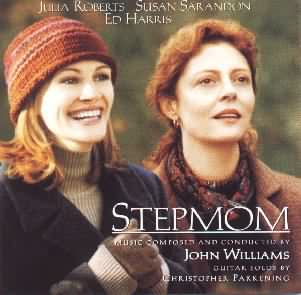
I had heard whispers of controversy about this score before my copy of the album arrived for review. "Not the best John Williams...self-derivative...", I had heard. True that Stepmom does not have a theme that is immediately arresting and memorable; rather, this score is subtly understated with long-breathed melodies and easy-flowing impressionistic music that, nonetheless, should invidiously invade the listener's affections on repeated hearings. And yes, there are many self quotations from E.T., Superman, and The Accidental Tourist to name but three John Williams scores but his consummate artistry weaves his older material into this new score so graciously that instead of being irritated, one welcomes their return like old friends. The overall mood is of gentle romance and family compassion. This is easy-listening Williams not far removed from Sabrina or Stanley and Iris and none the worse for that. The writing for the featured guitar (Christopher Parkening is admirable, sensitive and poetic) is lovely and occasionally very imaginative. The beautiful oboe playing of John Ellis should also have been acknowledged more emphatically with a front page booklet credit.
Stepmom stars Susan Sarandon as an older woman, Jackie ,who is supplanted by new younger wife (of Luke played by Ed Harris), Isobel (Julia Roberts). Circumstances force the two women to put aside their differences for the sake of the family that they now must share.
The opening cue "Always and Always" opens with a celeste theme against strings which suggests cosy domestic bliss - very feminine: delicate, pink, dreamy, hazy. As the cue progresses the music proceeds hestitantly - almost prayer-like. "The Days Between" carries this mood forward but there is soon a brief Copland tinge before the music proceeds introspectively; the oboe singing a song verging on sadness and regret. In this lovely cue the music is very reminiscent of Finzi, Moeran and other British composers and there is a subtle recollection of the Stanley and Iris music. The music is subtly Ravelian impressionistic too and the entry of the guitar softly tinges the music appropriately Spanish-coloured. "Time Spins its Web" is very evocative - an insistent clock ticking rhythm on strings with web-spinning piano arpeggios and clever rhythmic twists as the cue develops - a clever little invention. "The Soccer Game" is a quietly exuberant creation for the children at play. Again there is clever cross-rhythm writing and quieter music as we see the children's game through the women's eyes and are touched by their emotions and, fleetingly, their concerns and anguish: here, John Williams's astringent writing for guitar (I think) is especially compelling
"A Christmas Quilt" is another exquisite cue; cosily romantic and warmly nostalgic. Finzi comes to mind once more and there is an allusion to a well known nursery tune. The magic of the E.T. score and the Close Encounters music is recalled. Once more the oboe writing impresses. "Isobel's Horse" is a short cue for strings alone and it mixes Copland with string writing styles of British composers such as Holst and Elgar. There are some nice humorous touches too. "Taking Pictures" is guitar-led with another ravishing long-breathed melody strongly featuring the oboe. "Snowy Night" is very evocative of gently falling, twisting snowflakes with nice writing for the celeste again and the oboe. I was very much reminded of the feeling of isolation and disorientation of The Accidental Tourist score at this point and there are also reminders the remote beauty of "The Fortress of Solitude" from Superman. "Ben's Antics" bring us down to earth again with childish pranks. The music for this cue chugs along happily and comically but there is also an edge as we share the women's views and conflicting emotions once more. "Isobel's Picture Gallery" is music that has a remoteness suggesting loss (The Accidental Tourist again comes to mind); but the temperature soon rises and the music becomes poignant. There is an endearing delicacy and fragility about this cue which includes an attractive Ravelian piano solo part.
In "Jackie and Isobel" Christopher Parkening plays the main theme against a most refulgently romantic string backing - a ravishingly beautiful track and worth the price of the album alone. "Jackie's Secret" is slow-treading music beneath a mournful oboe - this is the most introspective and dramatic cue. "Bonding" continues this mood; it begins pensively, almost eerily before the tempo quickens and the mood lightens allowing the music to dance along - if rather reflectively but not unattractively. This is thoughtful, quietly brooding material with a softly veiled magic. The penultimate cue is the obligatory pop song, "Ain't No Mountain High Enough" but I cannot imagine it dinting the charts. The End Titles music rounds off the score magically with significant material for the guitar and oboe and piano.
Stepmom is not top drawer John Williams but it is nevertheless treasurable. I know this album is going to visit my CD drawer many times this year
Reviewer
Ian Lace
tar.gif)
But Jeffrey Wheeler is not so keen :-
For the man who reigns as undisputed composer & king of space opera music, it stands to reason that eventually he would tackle a subject slightly more earthly in nature... the soap opera!
Better than a typical underscore for "The Young and the Restless," "Stepmom" still cannot go beyond being John Williams' weakest since "Far & Away." Like "Far & Away," it is an enjoyable melodramatic score that nevertheless seems orchestrated with a paint-by-numbers kit close at hand. With kaleidoscopic musical effects recycled from "Always" (plus a metamorphosis from 'Follow Me' into 'Isebel's Horse and Buggy'), light comedic effects from "Sabrina," motifs lifted from "The Accidental Tourist," synthesizer elements carried from "Sleepers," a theme from an episode of "Amazing Stories," it plays like a compilation of John Williams' Dullest Hits. The redeeming highlights are the inviting guitar solos, superbly performed by Christopher Parkening, who regrettably appears on only four tracks and has an audible tendency to hum along that quickly becomes distracting.
Perhaps the most spectacular track is "The Days Between." Of the music on this disc, the track stands as Grade-A Williams material. Its bright orchestrations revolve around the film's main theme (a lengthy but pleasing melody) -- beautifully played and recorded, this is the soundtrack's centerpiece. A breathy reprise occurs during the end credits with an expanded Parkening solo.
That said, "Stepmom" improves as its subtleties come into view, an anti-populist tradition many of Williams' recent scores observe. The result is an average score that clearly aims much higher. It receives extra credit for the noticeable attempt, but it does not quite attain the goal.
The album's packaging is fittingly Christmas-y, but more interesting are the somewhat erudite gush-notes by director Chris Columbus. Instrumental performances are top-notch, but oboist John Ellis steals the show; he brightens the soundscape whenever he has the chance.
Reviewer
Jeffrey Wheeler.

EISLER The Hollywood Songbook Matthias Goerne (baritone) and Eric Schneider (piano)
DECCA 460 582-2 [70:09]
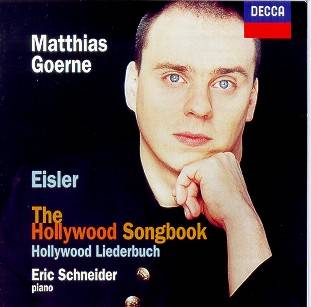
Eisler is one of those composers I have been meaning to explore. I have been intrigued by reviews of two competing versions (CPO and Decca-London) of his Symphony No. 2, Eine Deutsches Symphonie. His music has also appeared on Eterna and Berlin Classics discs. Here, at the other end of the musical scale, are 46 brief ,lyrically jewelled, songs. When I saw the title of the disc I thought of the sophisticated and slightly burly Weill show songs but nothing of the sort. Neither is this a Gershwin songbook. The music is spiritually, 'from the Old Country'. We are used to the nostalgic lyricism of lieder: the wayfaring lad far from hearth, heimat and heavenly delights. The intensifying lens of distance through which the exile views these images idealises them and adds a keen-edged poignancy. This is the currency of the musician and of German romantics in particular. For all of Eisler's socialist credentials it is this Shropshire Lad wistfulness which comes across very strongly in these Schubertian songs written in the USA.
The settings are by the classic poets of the Wolf, Schubert and Schumann eras: Hölderlin, Mörike, Goethe and Eichendorff; but the lion's share of the songs are to words by Brecht (30 of the 47 tracks), a fellow exile in California looking for work and having to compromise artistic standards in order to survive. Some of their shared revulsion of Hollywood and its 'ideals' comes across in tracks 26 and 29. He had escaped from one deadly oppression to another. While one threatened life (contemporary events are shaped by the song Panzerschlacht) the other threatened the soul.
Within Eisler's style the range is quite wide. This varies from the whispers of "An den Kleine Apparatch" [3] to the sterner "Auf der flucht" [7]. Only the piano accompaniment betrays (and then very rarely and subtly) his interest in atonality for example in two Pascal settings [18]. There is an atmosphere of magical entrancement in "Uber den selbstmond" [8] and in [25] a dream dance suggests memories of 'The Land of Lost Content'. Matthias Goerne has the delightful gift, by no means to be taken for granted, of careful balance, variation and shading of dynamics? Listen to way he tiptoes through the notes in "Der Schatzgraber" [28] and plunges deep into the lyrical melos in [22].
Good liner notes and full texts of the songs with translations (a few of the songs are settings of English words). There are so many highlights on this rare and treasurable collection. These include echoing bird calls [41], "Hotelzimmer" 1942 unleashing an unbounded lyricism and the wondering tenderness of Goerne's voice [42]. One of the supremely memorable moments is in "Später Triumph" with its declamatory storminess ending in a great Hokusai wave brought into our homes by Eric Schneider's vivid pianism.
Reviewer
Rob Barnett
tar.gif)
Editor's Note: Eisler was amongst the many artists: painters, writers and musicians who fled hostile regimes in Europe for what they thought was artistic freedom in America. Many were drawn by the artistic lure of Hollywood. Only a few were as successsful as Erich Wolfgang Korngold and Franz Waxman who had escaped Nazi tyranny in Vienna and Germany respectively. Fellow Austrian Max Steiner had arrived in America much earlier in 1914 as an emigré looking for a job in the music business in New York. Schoenberg, Stravinsky, Thomas Mann and many others lived in exile in Holywood, some made a fortune but most lived in conditions bordering on penury.
Hanns EISLER Orchestral suites Nos: 2 - 5 and songs performed by the
Ensemble Modern, chansonnier and conductor, H K Gruber.RCA Red Seal,
74321 56882 2 [70:03]
See also Hanns EISLER Orchesterwerke 1 [Suites for Orchestra Nos. 1 -4 ;
Theme and Variations 'Der Lange Marsch'; Kammer Symphonie]BERLIN Classics 0092282BC
This new Cd of music for silent and early sound films is of interest to film music enthusiasts for several reasons. First, little music survives from the European films of this period. Second, it includes documentaries - for which we have hardly any music. And, lastly it celebrates a "lost" film composer, a musician of considerable ability.
Eisler was a wonderful writer for voices, as we are now rediscovering with his Hollywood Songbook, his choral Deutsche Simfonie and his songs for the plays of Berthold Brecht - a few are included on this disc. He was also a talented orchestral composer but most of all he was a musician who believed that music should be at the service of everyone. Sadly, he had the great misfortune to be a German, a Jew, a communist and working in the middle years of this century. Consequently he managed to fall foul of the Nazis, the US un-American Activities Committee and finally, the East German Communists during a creative and productive life. A rotund and smiling little man, sometimes he had little to be happy about.
If he is known by film music lovers at all it is usually for the scores he wrote for RKO studios in Hollywood from 1943 to 1947. Or for his co-authorship of the 1947 book, Composing For the Films. Yet he had begun scoring in Germany in 1924 for a Walter Ruttmann experimental film and the Suites on this disc represent his main work immediately after that.
In Suite No. 2 the music from the 1931 pacifist story Niemandsland (GER.dir Viktor Trivas - all copies destroyed by the Nazis) establishes Eisler's pre-war style immediately. Jazzy, with atmospheric woodwind writing, black and white montages create themselves in your mind.
Suite No. 4 is from a 1932 documentary made by the great Dutch film maker, Joris Ivens. Called Pesn o gerojach in Russian [Heroes Song], it celebrates the Magnitostroj mines in the Urals. Eisler uses (as was usual in Soviet filmscoring) local songs as his inspiration. The result is a mixture of marches, heroics and jazzy Jewishness, both lively and tender.
Trivas is also the director for the 1933 French production Dans les Rues, which provides the music for Suite No 5. Its eight sections display a more reflective side to Eisler's writing to contrast with the brass scoring of the marches.
All the suites are interspersed with ballads and songs performed in a typical German cabaret-style which surely would have appealed to Eisler, cynicism mixed with a streetwise sadness, The disc's closing suite is No 3 from the 1931 film Kuhle Wampe (GER - Dir.Slatan Dudow). This tale of unemployment in Berlin is notable for being one of Brecht's few film scripts. Eisler's score drives the film along, giving the montage sections an optimism which sometimes contrasts with the events, notably in the 'searching for work' sequence - section [3] of this suite. It ends with an orchestral arrangement of the once world-famous up-beat 'Solidarity March', in this performance suitably bright and manic.
Some of the orchestral works exist on a Berlin Classics disc. But the bounce and tightness of the Ensemble Modern performances with their brisk tempos will appeal to today's audiences. And although the songs have no immediate movie connections as Gruber presents them they add a gutsy supporting period flavour to the whole collection. If you are exploring music as well as movie history this disc will repay your time.
Reviewer
Norman Tozer
tar.gif)
Leonard BERNSTEIN - Reaching for the note - his life in music Compilation of excerpts
DG 459-552-2 [155 mins]
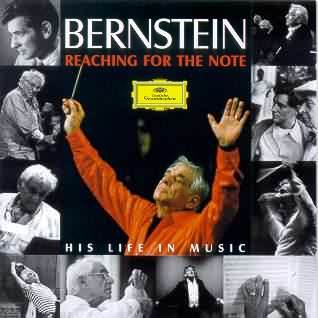
This 2CD album of DG recordings made by Bernstein later in his career (he had previously recorded for RCA and CBS), supports the PBS-TV documentary, Leonard Bernstein - Reaching for the Note (it was screened on British TV over the Christmas period). It is also a very useful accompaniment to Paul Myers's book on the composer, published by Phaidon Press, recently reviewed on this site; and a valuable introduction, for younger listeners to the art and music of Leonard Bernstein. It is a superb collection of Bernstein's work as conductor, composer and pianist.
The first CD opens with a passionate and thrilling reading of Schumann's "Manfred" Overture. This is the first time that this recording has appeared on CD. Next we have Bernstein's view of Aaron Copland's El Salon Mexico which crackles with life and vitality. Lenny then plays George Gershwin's blues-based Prelude for Piano No. 2. The remaining tracks are devoted to Leonard Bernstein's own compositions. There are two high-spirited songs from the 1993 live recording of On the Town, made by Bernstein's protégé, Michael Tilson Thomas: "New York, New York", and "Carried Away". (On the Town was filmed, brilliantly, in 1949, with Gene Kelly, Frank Sinatra and Jules Munshin with Vera-Ellen, Betty Garrett and Anne Miller.) From Leonard Bernstein's only original film music for On the Waterfront, we hear the beautiful Love Theme which is followed by the exuberant Candide Overture and June Anderson showing incredible vocal agility in her aria, "Glitter and be Gay" from that opera. From West Side Story (the 1985 recording with Kiri Te Kanawa and Jose Carreras), we have the Prologue, "Tonight", "America", and "Somewhere." The CD closes with "more difficult" Leonard Bernstein: The Prologue from his Symphony No. 2 "The Age of Anxiety"; and the Postlude to Act I of A Quiet Place.
CD2 opens with Kaddish 2 from Leonard Bernstein's moving Symphony No 3 "Kaddish", for orchestra, mixed chorus, boy's choir, speaker and soprano. The equally engaging and colourfully-dramatic, advanced rhythms of Psalm 23 from the Chichester Psalms follows for mixed choir, boy soloist and orchestra. We now turn to Leonard Bernstein as conductor of his beloved Mahler: first, the enchanting "Wenn mein Schatz Hochzeit macht" from Lieder eines fahrenden Gesellen with Thomas Hampson and the Wiener Philharmoniker, then a live recording with Barbara Hendricks and Christa Ludwig with the New York Philharmonic in two glorious excerpts from Mahler's Symphony No 2 in C minor "Resurrection"; and, finally, the famous Adagietto from Mahler's Symphony No 5 in C sharp minor. In contrast, we next hear the more strident and primitive dance rhythms from Stravinsky's The Rite of Spring. Three works by Leonard Bernstein follow: "To What You Said..." from his Songfest - a cycle of American Poems for six singers and orchestra; "A Simple Song" from the Mass sung by Cheryl Studer with the London Symphony Orchestra; and the Waltz from Bernstein's Divertimento for Orchestra. The programme ends with excerpts from two works by Beethoven: the Allegretto from Symphony No.7 in A major; and the final chorus - "Ode to Joy" from Beethoven's Choral Symphony No 9 in D minor, associated in everybody's hearts and minds with the tearing-down of the Berlin Wall.
Needless to say all these performances are dazzling and all are recorded in superb sound.
Reviewer
Ian Lace
tar.gif)
Jerry GOLDSMITH Star Trek: Insurrection OST
GNP Crescendo GNPD 8059 [44:46]
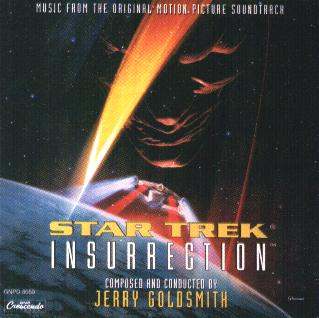
The philosophy in putting together this movie was to distance itself as far as possible from the ‘scary’ darkness of the previous (First Contact). The shame is that no matter how commendable Paramount’s thinking ever is behind the latest in the trek franchise, they still mess up at the script stage. All 3 of the Next Generation outings have been flawed, and this latest suffers most from the feel of merely watching an extended episode.
A personal observation of mine is that an opening credits sequence that runs titles over footage is a self-defeating mistake. It’s understandable for a TV movie, which wants to cram as much into its time slot. A feature movie needs to hook its audience from the start. Independent title sequences allow for conversations to finish up and packets of edibles to be opened (groan). More relevant to the purpose of this review (!) is that it allows a composer to show off their colours. Insurrection opens on a touchy-feely community going about its bread baking, clothes
mending daily life. Cue one very tedious tinkling piece ("Ba’Ku Village") from Trek regular Goldsmith. It immediately and unintentionally demonstrates how devoid of drama the film is going to be.
It moves into some opportunity for dramatic writing however, but only minutes into the score its second major downfall is presented. That being exceedingly flat action writing, sounding oh-so reminiscent of the by-the-numbers drum ‘n’ brass of recent offerings such as: US Marshals, Small Soldiers, and Air Force One.
Some overspill work on The Ghost & The Darkness clipped the amount of available time Goldsmith had on First Contact. An inspired collaboration resulted, with his son Joel providing excellent material for the enemy Borg. His pieces featured some terrific samples amongst the orchestra, but the use of electronics remains about the best that score had to offer. Now with Insurrection, Goldsmith Snr unfortunately demonstrates problem # 3 - a very poor use of electronics indeed. The one memorable piece he has crafted for the film is a romantic theme for Picard’s unrequited love, but in its most pleasing appearance ("New Sight") it is ruined at the end by some grating sound effects.
It seems inconceivable that the innovator behind the use of the Blaster Beam in The Motion Picture should consider wee-wee-wee noises appropriate for the shock appearance of a hidden science observatory. Yet there it is.
Mr Goldsmith had a very full year in 1998, and since that included Mulan and LA Confidential, we’ll let this one slide.
Reviewer
Paul Tonks
tar.gif)
Yet Ian Lace is more enthusiastic:
Although I would hesitate to claim that his new Jerry Goldsmith score is amongst his best, it does contain some very attractive material. The plot, with its emphasis on the philosophical contrasts between the enlightened peace loving Ba'kas and the antagonistic and vengeful Sona's, as much as the usual Gung-ho heroics, gives Goldsmith the opportunity of presenting a more varied and richer score than say that of Air Force One.
The opening cue "Ba'hu Village" opens, significantly, with an attractive serene theme before the score darkens to admit more threatening figures with music that has great vigour and rhythmic vivacity. I was struck by the subtlety of the electronics in this context; I was given a vivid impression of combat tracer fire patterns. Also in this multi-dimension cue (and in "End Credits") we have reprisals of Alexander Courage's original Star Trek theme and Jerry's theme from Star Trek: The Motion Picture acting of course as thematic links in this continuing saga.
I was particularly drawn to the quieter cues, again using electronics sympathetically and unobtrusively integrated with the orchestra. "Childrens' Story" is a lovely, innocent impressionistic evocation. The beauty of "New Sight", the stand-out cue on the CD is again very impressionistic reminding me, in places, of the music of Debussy and Respighi; it has mystical connotations too. In both of these cues there is a sense of wonder with flutes, strings and harps magically combined with quietly tinkling electronics. Another impressive cue is "No Threat". It begins with an impressive combination of those tracer electronic patterns over percussive piano ostinatos and increasingly threatening horns before the music rides out in those interesting staccato cross-rhythms; but then the textures thin and you sense peace is restored. The point I am trying to make is that here we have here just one example of Goldsmith's superior film music craftsmanship: consider his control over weight and balance of texture and dynamics, the sheer richness of his harmonies, his great rhythmic drive and sense of dramatic timing and contrast.
Some of the combat music cues are less impressive and one can criticise some of the cloying sentimentality that spoils "The Healing Process". Nevertheless, there is enough in this Goldsmith score for me to reach it down and put it in my CD drawer more than once.
Reviewer
Ian Lace

GNP Crescendo invite you to visit their site: http://www. gnpcrescendo.com
Basil POLEDOURIS Les Misérables OST
MANDALAY/HOLLYWOOD 162 147-2 [49:17]
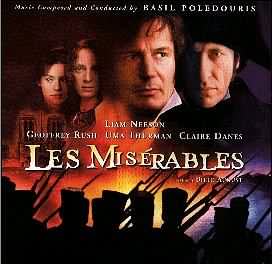
Any score by Basil Poledouris is worth the closest attention and this one again confirms his great strengths and high standing in the lists of feature film composers.
This recording is grouped into four tracks with one suite to each track. While the individual movements are listed on the sleeve they are not separately banded.
The first suite (Valjean’s Journey) opens in a Sibelian rustling (En Saga). Soon an atmosphere of understated heroism is established by a robust theme (of which Poledouris makes extensive use throughout the score). The music is tense and is carried along by a glowing sea-swell. The melodic content is fine, wide and wandering and of epic quality. The tale of the big theme has a biblical edge, rather typical of the end of one of Rózsa’s big moments in a Middle East spectacular.
Vigau (Suite 2) has some of the same spirit that imbues the first suite as well as a piercing sensitivity. Paris (Suite 3) conjures up memories of the gentler parts of Poledouris’s 1980s Conan scores. There is also a ‘grand ball’ variant of the big theme contrasted with strong grand-stepping rondo straight out of the pages of Conan. Plangent harp work towards the end of suite makes an abiding impact. Suite 4 (The Barricades) spins the same big theme through the full grandiloquent treatment played over thunderous drums. This relaxes into angelic serenity (7:22).
It is worth mentioning that the orchestration is by Lawrence Ashmore whose characterful and sensitive work in providing orchestral accompaniment for the Gerald Finzi Five Bagatelles (originally for clarinet and piano) has been a great service to music. These have most recently appeared in a very good Finzi collection on Naxos (8.553566) but previously featured on an RCA collection where the solo was taken by Richard Stoltzman.
It is customary to provide deficient documentation for contemporary OST discs. Hollywood do not break from tradition. There are some good studio stills.
The film stars Liam Neeson, Geoffrey Rush, Uma Thurman and Claire Danes and as far as I am aware has not as yet been released here. The release must be imminent.
The disc plays for over an hour and is well worth acquiring. The composer makes the most resourceful use of his material and there is a great deal more variety in this score than the recent ‘Lonesome Dove’ collection from Sonic Images.
Reviewer
Rob Barnett

Ian Lace adds -
Another powerful and compelling score from Basil Poledouris for yet another version of Victor Hugo's classic novel. Poledouris's richly textured and beautifully crafted music is darkly dramatic, as befits the relentlessly tragic nature of Hugo's drama. Much of the score is taken over by relentlessly repetitive rhythms: cold, malicious and dark for the twisted obsessive nature of policeman Javert contrasted with warmer figures for the noble, honourable and compassionate Valjean.
The musical cues are divided into four suites of unequal lengths roughly following the four main episodes of the story: Valjean's Journey in which Valjean steals bread out of sheer necessity and Javert begins his savage and persistent pursuit; Vigau in which Valjean attempts to carve a new life for himself, cares for the poor Fantine, rises to a position of civic responsibility but has to flee when Javert is hot on his trail, Paris where he his daughter Cosette is now a young beautiful woman, and The Barricades in which Valjean is caught up in the insurrection in the streets of Paris and where he has his final confrontation with Javert. This splitting of the music into suites is a new presentation affectation; I first encountered it with Varese Sarabande's The Private Lives of Elizabeth and Essex. I cannot say I am thrilled with it. Unless the CD player display tells you which of the sub-cues within each of the suites you are listening to, this arrangement can be annoying. My player only recognised four cues for the four suites. (Yes, I know there are pauses in the flow of the music to indicate where one sub-cue ends and the next begins but often a listening experience of twenty minutes is interrupted)
The first suite opens with a plaintive oboe melody over quietly pulsating strings, sadness and a sense of hopelessness is communicated before stronger more heroic material enters suggesting fortitude and resistance against injustice and a malign fate The music of this opening cue maintains this sense of conflict and it carries over into Suite 2 as Javert is consumed with suspicion when he is in Vigau but most of the material of this suite is warmer underscoring Valjean's compassion and love for the poor Fantine. Snare and bass drum figures suggest a cold, ruthless machinery of justice as represented by Javert's sneering pursuit. Suite three contains some of Poledouris's most attractive music scored brilliantly for harp and woodwinds to describe Fantine's daughter now a lovely young woman and with Valjean in Paris. Suite Four has stirring, heroic music for the Parisian street battles and Poledouris cleverly underlines the emotional complexity of Valjean's final confrontation with Javert when the latter finally realises the injustice and utter madness and futility of his pursuit and the shock of the revelation sends him over the edge and compels him to commit suicide.
Reviewer
Ian Lace

Miklos ROZSA The Golden Voyage of Sinbad OST Music by the Rome Symphony Orchestra conducted by the composer
PROMETHEUS PCD 148 [54:07]
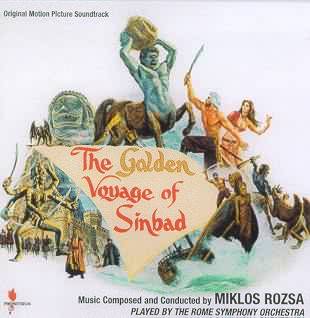
This is the CD version of the original OST LP album from the 1973 Columbia film. Interestingly the producers wanted to have Bernard Herrmann, who had worked with Ray Harryhausen on his animated fantasies, to score the film but by this time Herrmann was tired of the genre and declined the offer. Rozsa, of course, had experience of Arabian Nights fantasies through his score for Korda's The Thief of Bagdad. In his interesting preface to the analysis of this score, Rozsa relates how he managed to diplomatically steer the producers away from the notion of a more commercial "Pop- based" Main Title cue. He points out the difference as he saw it between the two films and the two scores. "Although both pictures were inspired by the same source, they were basically different. The first (The Thief of Bagdad) was a romantic tale, full of poetry, not lacking of course the fantastic elements like ...the Djinie who lived in a bottle. The new Sinbad lacks romance and poetry, but makes up for it in adventures and with animated monsters brought to life by the brilliant Ray Harryhausen...The first part of the picture takes place in Arabia, therefore the music has an Arabian character, but then Sinbad navigates towards India, so the music changes to the style of the Indian ragas, but of course both highly stylised, because we are in the land of fantasy. All situations and personages have their distinctive identifying themes throughout the picture."
The early music is very reminiscent of Rozsa's scores for his Biblical and historical epics. His film noire scores are also recalled in the music associated with the evil wizard, Prince Koura. The score is not as melodic as much of Rozsa's work. Melody is reserved for Sinbad and the heroine, Margiana. It seems that the influence of Herrmann rubbed off on this score for the motifs that are used for the monsters are brief and often dissonantly pointed and blended into fast moving action or darkly dramatic music; however, overall, the familiar Rozsa fingerprints are clearly discernible. Indeed, it is interesting to compare this score with, for instance, Bernard Herrmann's music for Ray Harryhausen's The 7th Voyage of Sinbad.
The opening main titles is pure opulent Rozsa garnished with quasi-Eastern mysticism. Cue 2 uses a synthesiser to startling dramatic effect to evoke a strange flying creature that swoops over Sinbad's ship to drop a golden amulet on the deck. In "The Dream" Rozsa uses harp glissandi and eerie strings with woodwinds and sinister brass figures to illustrate the myriad images that Sinbad sees in his vision. "The Storm" is another powerful evocation of turbulence at sea, you feel not only strong gales shredding sails and torrents of rain lashing the ship, but also an evil machination behind it all. Cue five is more reflective as Sinbad ponders over these events and the ship anchors before Sinbad swims ashore. The next cue, with some interesting brass writing, concerns Sinbad's first confrontation with the evil Prince Koura. The meeting with the Grand Vizier whose face has been mutilated is the subject of the next cue dominated by tremolando strings to turn the music creepily malignant; yet at the same time there is a poignant edge to it. Cue 8 is more placid and romantic for the beautiful slave girl, Margiana, one of Rozsa's lovely lyrical creations, but at length, clouds gather and the music grows increasingly threatening. Back aboard the ship, the evil Koura brings the Siren figurehead of Sinbad's ship to life and to Rozsa's dangerously sultry music, she fights the crew to steal the chart to the treasure of Lemuria Island. Rozsa uses xylophone, nasally muted brass and frenzied swirling strings to depict the conflict on the ship before the Siren makes off with the chart before deep bass chords signify her sinking into the ocean.
The bringing to life of the bat-like monster, the Homunculus is very imaginative, its abominable screechings created with a judicious use of the ondes martenot (which Rozsa had used to such wonderful effect for The Lost Weekend and Spellbound) intermingled with eerie woodwind and string figures. The "Arrival on the Island of Lemur" prompts music of Indian rhythms; this is music of caution and curiosity as Sinbad's crew explore the island and then unresolved high-pitched string figures to represent the "Temple Keeper" summoning the oracle. Weird staccato effects and synthesiser mix with Sinbad's theme when the Homunculus attacks the party in "Escape from the Temple" After beating off Homunculus, another threat appears in the shape of the six-armed statue of the Goddess Kali brought to life by Koura. Rozsa makes her sensual and powerfully dangerous and her combat with Sinbad is intense and close-fought before Sinbad triumphs Bells and cymbals accentuate the miraculous nature of the "Fountain of Destiny" with Rozsa in full romantic flow again then darkly dramatic as Koura is rejuvenated by its waters. A cavernous four-note tuba motif introduces the Centaur and horns announce the winged Gryphon The beasts engage in combat to the death with the Centaur victorious - Rozsa's music recalls his Quo Vadis score here in addition to more lumbering figures and grotesque orchestral slides for the heaving efforts of the gigantic monsters. The Centaur then turns his attention to Sinbad but is bested by the hero. In the penultimate cue Koura is confronted by Sinbad for the last time and the evil Prince killed. The music here is sly and slitheringly sinister, mixed with very realistic sounding parry and thrust sword-play figures. The final cue is of splendour and celebration as the Grand Vizier regains his crown and Sinbad sets sail for home with Margiana at his side.
The CD's documentation is exemplary with good track analyses (although there are 18 not 20 as published with two cues combined not separated as announced). A valuable addition to the Rozsa discography.
Reviewer
Ian Lace
tar.gif)
Geoffrey BURGON Television Scores: Cider with Rosie; When Trumpets Fade; Silent Witness; Turning World OST conducted by the composer
SILVA SCREEN FILMCD 306
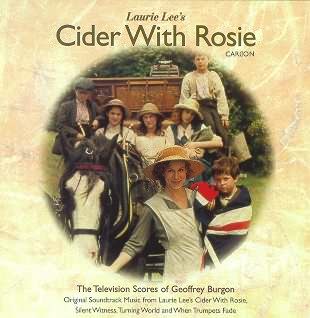
Burgon is very much associated with melodic-impressionistic (often slow-paced) music for British television dramas from Brideshead Revisited (his most famous score) and Testament of Youth to Tinker Tailor Soldier Spy. The music is sweetly tuneful with tart textures.
This disc has as its focus Burgon's incidental score for the Christmas season broadcast of a new adaptation of Laurie Lee's book. This has been done previously and with considerable success though why someone hasn’t selected :Lee’s sequel 'As I Walked Out One Midsummer Morning' I do not know. An imaginative though expensive decision given that the As I Walked ….’ would have involved filming in Spain. The longest of the Laurie Lee tracks is just under three minutes and most are between one and two minutes. These 'building blocks' act as atmosphere builders and texture fillers. In the first track, Lee, who died shortly after the recording sessions, reads a section of his book. Burgon is a master at summoning the shimmer of summer days [2] and the urgent buzzing of insects [3]. Light [7], Finzian contemplation [Laurie and Jo] and heat-hazed landscapes all rise up in front of us. Japanese harp chords counterpoint Bachian tectonics of shifting string strata.Track [4] is a bucolic brass-band march partnering track [6] a village dance with the deep rumbling of a bass drum, a panoply of rustic characters and the subdued bustle of the village market place. In track [5] a light summer wind gently stirs the green leaves. The bittersweet music of track [12] offer a memory of The Lark Ascending. This predominantly slow-paced score is closed with the sorrowful "Laurie Leaves Home".
When Trumpets Fade is more urgent. The tart textures of brass and sax over subdued percussion hint at an underlying tension and then conflict. The developing urgency of the sax betrays a pulse worthy of Nyman.. The compilation of sax and flute is striking. In this score Burgon throws off his reputation for slow-paced music adopting a lively life-intense approach with a paean for brass and drums.
Silent Witness (a series about a police scientist) uses the sinister and chaste effect of the human voice. Track 21 has a wailing effect like the sirens associated with events whose legacy she investigates. The other tracks are sinuous, bright, sinister and finally the selection closes with a piano solo dance prelude. In The Turning World a psychiatrist from India is seen working in the southern counties, forgetting his past and having it catch up with him. Predictably (but still effectively) Burgon deploys various Indian effects and instruments. In track 32 a buzzing turbulence and eldritch shuddering produce a powerful effect suggestive of a nightmare transformed into reality.
It is a pity when so much attention is given to Cider With Rosie that fans of Silent Witness and the other two features may overlook the album. There are brief but reasonably adequate notes. The orchestra is unidentified - no doubt a contract ensemble. Although the CD is not as extensively-filled as many this is a very fine recording of attractive music in brightly minted sound.
Reviewer
Rob Barnett
tar.gif)
Ian Lace adds:-
One of the delights of this album is the reading by the late Laurie Lee, himself, recollecting his first sexual encounter - with Rosie. Cider with Rosie was screened on UK television over Christmas just past. Burgon's music evokes a quiet secluded English countryside that just about persisted through to the end of World War I and a little beyond before the motor car, the cinema and the radio (known as the wireless then) swept away the old world forever. This suite, performed by a small chamber ensemble, with often an accent on the brass for colour and character, comprises 12 short movements. The music nicely reflects the innocence, sadness and tragedy of those times. The Introduction sets the scene with broad pastoral music at once nostalgic and sad as the family arrive at their new country home with their belongings piled high on a cart. 'Our Mother' a poignant cue for strings tells us much about Laurie's pleasant, capable and optimistic but delightfully/tragically naive and gullible mother. "The Outing" is a fine piece of character comic writing for the charabanc (coach) outing to the seaside complete with inebriated driver. Strong, agitated string writing, with a comic end piece, informs "Sid Does it Again." The music for the mad "Miss Flynn", a rather pre-Raphaelite-looking figure, with her flowing red hair and long velvet gown is one of the highlights of the score - delicate harp pizzicati stress her beauty and sad vulnerability while high string figures and steely, edgy strings, low bassoon musings and isolated percussion strokes show her mental disorientation. The music for "Sent to the Workhouse" accompanying scenes where an old couple, who have lived together for forty years but are no longer able to look after themselves, are sent to the workhouse where they are separated and die only days afterwards, is most sympathetic. The suite ends gloriously with "Cider with Rosie" then with a soft nostalgic glow, in the final cue, as Laurie reaches early manhood and prepares to leave his family to make his own way in the world.
When Trumpets Fade is scored mostly for brass: trumpets, trombones and tuba with saxophones, with percussion, often combined grotesquely, frequently in distorted jazz rhythms for this story about an infamous World War II battle in the Hurtgen Forest in Germany in which thousands of men met their deaths pointlessly. Strings, in the last cues balance military madness with sanity, humanity and poignancy but in the main, the music is brutal, dissonant and sometimes darkly comic. It certainly fulfills its mission to underline the senselessness and waste of war.
Silent Witness is the BBC TV series about the work of and life of a pathologist. Again Burgon uses limited resources to wonderful effect. (One wonders how much more he could achieve if he were given a bigger budget and a larger ensemble for his television scores - see my comments on television scores in my Master of Ballantrae review in the January reviews on Film Music on the Web). This is full-blooded, scary, horror music. "Requiem" the opening cue sets the mood - voices wail over dark, brooding and shadowy figures. "Death in the Shower" begins in a slightly more upbeat manner with an insistent rhythm which has a hysterical edge but then horror arrives with dark slithery stealth followed by sudden violence and cold death. "Silent Nocturne" is again full of creepy-crawlies. The remaining tracks, some scored with warmer music for relief like "Waiting" with its attractive piano solo, are all very cleverly scored are in the same broad vein.
Turning World is about the life of a Pakistani psychiatrist working in a mental hospital in the south of England. Burgon writes a darkening dramatic score that nicely balances and contrasts Asian ethnic music with conventional western modes to illustrate the character and neuroses of the psychiatrist's patients and the growing pressure on himself that will eventually push him over the edge into madness.
An adventurous collection.
Reviewer
Ian Lace
tar.gif)
Lalo SCHIFRIN Rush Hour OST
ALEPH 005 [47:22]
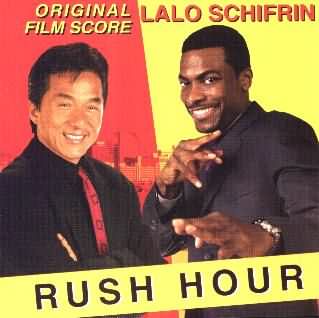
Director Brett Ratner took on this film seeing it as an opportunity to pay homage to his all-time favourite - Enter The Dragon. Where exactly that is paid off on the movie I’m not sure. It’s got Jackie Chan, and lots of oriental references, plus the innovative fight sequences. Principally what Ratner meant was the opportunity to re-visit Dragon musically by capitalising on the relationship he’d established with Schifrin from their collaboration on Money Talks (also with Chris Tucker). He purposely cut the opening of the film & temped it with the Dragon theme, so that Schifrin would create a 90’s twist on his classic. This kind of attention to and reverence of film music is pretty much unheard of today. A shame, since this score proves just how beneficial that kind of thinking can be.
The "Main Title" bears a passing familiarity with Dragon’s, but is based around a much longer melodic line. It is hugely memorable, and is backed by all manner of percussive rhythms and Chinese instrumentation. It is a template for the body of the score; lots of brassy calls backed by rumbling drumrolls and picked out by numerous rattling live or sampled ethnic beats. "Fight At The Harbour" is an early example of the textured writing. In "Chasing Sang", the thrashed out beats are heart-pounding. Alongside the unpredictability of where the percussive line is going, this is Schifrin to a tee.
Other highs for the chopsocky action come in "Lee Arrives In LA" (which includes a phrase most closely ascribable to Dragon). This cue swings back and forth between variations on the main theme, & funky grooves on guitar for Tucker’s wise-cracking character. "Battle At Juntao’s" features elongated sweeps from both orchestra and samples, and in "On Juntao’s Heels" it’s a case of Holst meets Wagner. Mars’ unmistakable rhythm introduces and is then overtaken by the salutary fanfare of the Valkyries. Quite a mix !
It is not all tam tam crashes and guitar wailing though. "Soo Yung’s Theme" is for the young girl kidnapped. Although it opens somewhat covered in sugar, the sampled flute gives way to an oriental style that again carves out a memorable melody. "Lee’s Sadness" is a very touching piece of melancholia for subtle strings, which helped pave over any excesses in Chan’s acting in the film.
All the way through you can’t help but be impressed by ways in which Schifrin weaves the main theme into the whole. "Sweet And Sour" contains almost subliminally subtle arrangements for strings. By the time the reprise for the "End Titles" comes around, it is inconceivable that it won’t have been indelibly implanted in your head.
Reviewer
Paul Tonks

Martin KISZKO The Battle of the Sexes Incidental Music to the BBC wild life documentary series on The Natural History of Sex City of Prague PO/Harry Rabinowitz
BBC MK1103 (distributed by Silva Screen) 60:57
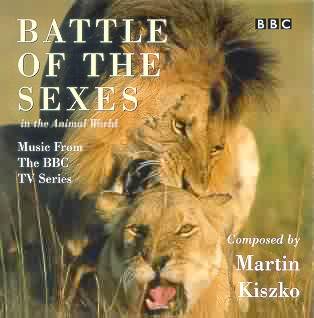
Martin Kiszko has previously contributed highly effective music to the British TV series Alien Empire, The Realm of the Russian bear and Land of the Eagle. Here his music graces (and that is the word) the BBC Natural History Unit’s latest 6 part documentary which examines the sexual act in all its forms. Kiszko assisted Edward Williams in the score for David Attenborough’s Life on Earth series from 1980.
The title track is stormy and features a grand theme. A whooping clarinet cutting right through the texture at one point is a very memorable touch. There is a gutsy turbulence in the skirling horns and a hint of what you might call Hollywood ‘Red Indian’ music adding a dimension of threat. In ‘Another world’ (2) there are hints of John Barry but I do not want to take away from the fine inspiration which pervades deeply velvet, romantically tender harp and flute dialogue and gentlest touch of the strings. This also surfaces elsewhere notably in tracks 4 and the final track interspersed with birdsong. Forays And Foreplays (11) has a decidedly Stravinskian tinkling motif which return in track 17. A jazzy, sinuous and slightly sleazy clarinet slides in Gershwinnying fashion up and down the scales in ‘Jazzed-Up Males’. In ‘Reluctant Hunters’ a solemn cello soliloquy takes centre stage. The cool, concentrated and immanent threat in of The Deep comes over strongly in track 10. Track 12 is notable for the insistent little rhythmic figure for higher woodwind. In track 17 Kiszko produces an excellent warlike ‘mongol horde’ type theme.
This is a classy, straightforward and richly impressionistic score which remains entertaining and even when separated from its images.
The notes are good. They include discographic information, compact information about the series by its executive producer, an ideally balanced note by the composer and a profile of the composer. I hope that before too long Martin Kiszko will become a name we associate with feature film scores as well as TV.
Recommended
Reviewer
Rob Barnett

There are more >>>>>>>
© Film Music on the Web 1998. All rights retained. Reviewers retain copyright on their reviews.
COMPETITION WIN a CD of your Choice from Crotchet

Search the Crotchet database from here
Discs on these pages are offered for sale. There is also a page of search engines from a selection of on-line retailers here.
Please support this web-site by buying your discs here.
Disclaimer: Every effort is made to make sales links to the correct disc but, in the end, you must take responsibility for checking that what you are purchasing is what you want. Some of these discs were not actually available for sale at the time of posting but a link has been made in anticipation of their forthcoming availablility.
Return to Index Page
e-mail Len Mullenger len@musicweb.force9.co.uk